|

SEGA: to be this old means
you've been around for AGES.
Here
is my pick of the best coin-op games ever to appear under the
Sega name.
It
is a name I've seen in arcades all my life. A few years ago I
saw a Sega fruit machine (for sale second hand) that used pre
decimal money!
The company we know today as Sega came together from the merger
of many different companies. In the first years of the 1950's
America was fighting the Korean War. US soldiers were often based
in Japan. To entertain these customers a company named Nihon
Goraku Bussan started to import pinball machines and jukeboxes.
In 1965 they merged with a company run by ex US serviceman David
Rosen. Rosen had been importing air-rifle games and other
coin-operated entertainments since the late fifties. The brand
name Nihon Goraku Bussan used was Service Games. This was
abbreviated to Sega and the merger with Rosen Enterprises
gave the now familiar Sega Enterprises Inc.
When Space Invaders became popular Sega developed video
games of its own and also acquired a US company Gremlin Inc.
Many of the games I feature here were developed in the US and
appeared under the name Sega/Gremlin or even Gremlin/Sega. Namco
gained a lot of criticism when they went back to the early 80's
and even the late 70's in some cases for their retro compilations.
The Sega Ages pack released in the UK contained relatively
sophisticated games starting from 1985. But this meant they missed
out many classics (and a few duff ones too).

The first video game I've found baring the Sega name is something
of a surprise. Fonz was a 1976 game based on the hit TV
show Happy Days. The slogan went, "TV's hottest name,
Your hottest game". It was a simple motorcycle game that had
handlebars on the cabinet. You had to go as fast as possible without
skidding off the road or hitting another bike.
The next two are sure not to show up on any proud Sega retrospective.
Space Attack (below left) was a colourful Space Invaders
rip-off and Invinco was another Space Invader clone but with non-alien
targets. 1979's Head-On (below right) was a top down viewed
car game. There was a maze of passageways from which you had to
collect dots. Your aim was to collect them all without colliding
with the computer car coming in the opposite direction. The game
definitely crosses the line into impossible and frustrating. It
also is exactly like the 1978 Atari VCS cartridge Dodge'Em.
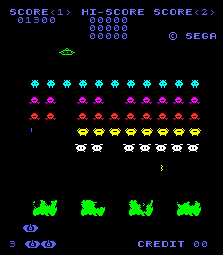 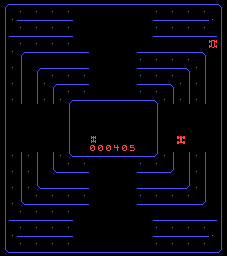
Monaco GP from 1980 is a driving game I remember well.
It had a huge cockpit cabinet and a large padded steering wheel,
accelerator and gear stick. There were speakers positioned in
front of and behind your head. The sound of a passing car would
move between these speakers to great effect. The game itself was
an avoid-the-other-cars type with an overhead view. However many
additional ideas were added to the mix to make it quite special.

One nice touch was a night section where you only got to see a
tiny fraction of the road in your headlights. Risky but lots of
fun. Sometimes the track became blue in colour, indicating treacherous
ice. The siren of an ambulance would sound every so often. This
was your signal to move aside as it made its way down the centre
of the screen. There were also the occasional bottlenecks were
the road narrowed drastically. The game would give you a warning
of danger just before the road narrowed. Many of the ideas in
this game found their way into the driving games of other companies.

"Fighter Pilots needed in Sector Wars. Play Astro Blaster!"
These words always attracted my attention in the arcade to this
excellent shoot-em up. The enemy formations and behaviour were
very varied, with 29 waves to be seen. The graphics themselves
were detailed, animated and often used colour cycling.
Firing
aimlessly worked against you. Your laser could overheat so every
shot had to count. One lifesaver was the warp button. Hitting
this in tight spots slowed the enemies down to a crawl giving
you time to wipe them out in safety. After four waves you scrolled
through an asteroid field that gave you the opportunity to shoot
fire balls for extra fuel. Speech was just the topping as the
game featured excellent sound effects throughout. A classic.
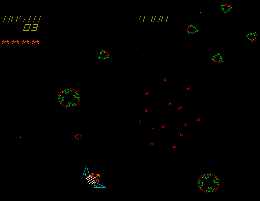
Space Fury from 1981 (above) was the first colour vector
graphic game. This shoot-em up had elements of Asteroids but took
the idea much further. Each wave consisted of alien sections that
would drift together to make one large baddie that would then
attack you. The pieces or the whole could be shot but only a complete
alien could shoot a fireball back at you. Between the levels you
could dock with extra weaponry to give extra directions of fire.
Colour was well used and speech allowed the head alien to taunt
you. Space Fury was fast and frenzied.
Eliminator is another vector graphic game with some of
the coolest explosions in history. The Eliminator was a craft
at the centre of a rotating base. You were killed on contact with
the base but a single shot down the moving tube of its centre
would finish it off. Over time the Eliminator ship grew until
it finally left the base to come after you. More fun was to be
had playing against three other human opponents. To advance further
in the game your best bet was to co-operate. Your shots however
would bounce the other ships around the screen often straight
into the eliminator. Multiplayer games could often turn into huge
grudge matches with players more intent on destroying you than
the eliminator!
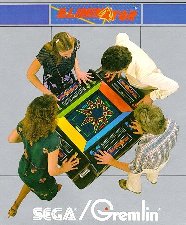
Pulsar is a real forgotten gem. Viewed from above you controlled
a little tank around a maze. The aim was to reach coloured keys
at the top of the screen and deliver them to the locks at the
bottom. The walls of this maze however, constantly disappeared
and re-appeared. This could stop you from where you were trying
to get or miraculously open up a new path. The detailed graphics
showed many little enemies that needed to be shot or avoided.
Fast fun.
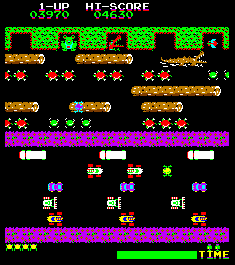
Frogger is one of the ultimate single screen games. The perfectly
balanced gameplay gave you a simple task that hooked you from the
start. True thumb candy. For a full look at Frogger check out the
article in issue 12 of RETROGAMER
fanzine.
Turbo
was a graphically advanced driving game. It took many of the ideas
of Monaco G.P. and added a 3D perspective. You drove through cities
and countryside in varying weather conditions. Your aim was to
pass the required number of cars while not hitting them or the
ambulance that occasionally sped by. A great version (complete
with steering wheel and excellerator pedal) was released for the
Colecovision home console.

Pengo (1982) was a game of supreme cuteness than disguised
a tough challenge. You were Pengo the penguin on the run from
the Sno-Bees. These had to be squashed with well-timed
pushes against ice blocks. The gameplay was frantic as you manoeuvred
around avoiding contact with the sno-bees. There is a wonderful
animation if they get you. You lie on your back crying and flapping
you wings and legs! Great music too.

Tac/Scan
was another excellent vector game from 1982. You controlled a
formation of seven little ships. They were steered with a paddle
around the passing bad guys and could dispense serious firepower.
The unique bit was that each ship could be destroyed individually.
It was game over if you lost them all but extra ships could be
obtained in play to fill the holes in the formation. The game
had three stages. The first was a vertically scrolling section.
The second saw a wonderfully fluid shift to a third person 3D
view (below). This was the toughest part as you were pestered
by a flying saucer and enemy fireballs screamed towards you. The
last part saw you steer the formation down a twisting space tunnel
into the next galaxy. Any ships colliding with the edge of the
tunnel were destroyed. Lots of variation, great sound and cool
changes in perspective made this a real classic.

1982's Zaxxon was a jump in sophistication for raster graphics.
This game also had the distinction of being the first arcade game
to have a (US) television advertising campaign for it alone. I
remember it being very hard to judge your height at first. Gradually
though, players got used to the isometric viewpoint. At its heart
it was a fun shooter that had you infiltrating an enemy base.
With missiles being launched from the ground right next to you,
forcefields to avoid and many baddies to blast, it was stuffed
full of good ideas.
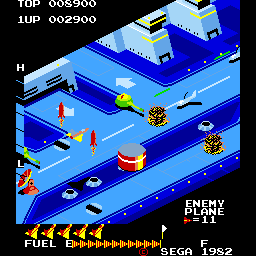
 Star Trek came out around the launch of the second feature
film. It was the last of the Sega vector games. It had a screen
that was divided into three sections: the helm view from the Enterprise,
a map view of the ships nearby and a box
with gauges to show shield strength, warp capability and photon
torpedoes. Most levels set you the task of defending a starbase.
Manoeuvring around space to destroy the Klingons soon became second
nature. Once a sector was secured you moved onto the next level.
A computer voice would tell you, "Damage repaired Sir", and it
was on to the next level.
Star Trek came out around the launch of the second feature
film. It was the last of the Sega vector games. It had a screen
that was divided into three sections: the helm view from the Enterprise,
a map view of the ships nearby and a box
with gauges to show shield strength, warp capability and photon
torpedoes. Most levels set you the task of defending a starbase.
Manoeuvring around space to destroy the Klingons soon became second
nature. Once a sector was secured you moved onto the next level.
A computer voice would tell you, "Damage repaired Sir", and it
was on to the next level.
Upn'Down
brings us into 1983. Here you controlled a little buggy down single
lane paths. The aim was to collect coloured flags without hitting
other vehicles. A joystick steered the car and a single button gave
a jump. A well-timed jump on top of an enemy car would destroy it
but clipping it or just colliding with it lost you a life. The game
had a compulsion that meant you just had to spend another 10p if
you were just one flag off reaching the next level. It was punishingly
hard though.
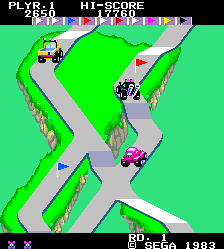
Spy Hunter (below) is a 1984 game that many players remember
fondly. You raced a powerful gun fitted sports car along a treacherous
highway viewed from above. Your aim mainly to survive while destroying
the enemy cars and not harming the innocent vehicles. Sometimes
you could force enemies off the road; sometimes they knocked you
for six. Every so often you could drive up the ramps of a friendly
supply truck to gain another weapon. These included missiles,
oil and a smoke screen. Sometimes a fork in the road would descend
to the sea and your car would magically transform into a speedboat.
Here you met more villains with names like Barrel Dumper
and Doctor Torpedo.
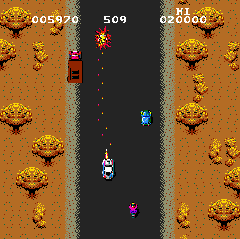
I'll
leave the Sega story there. Suffice to say that before they discovered
hydraulic cabinets Sega produced many small arcade games with
huge amounts of gameplay.
This document is copyright 1998-2001 Keith Ainsworth and can
be found at the Retrogamer fanzine site: http://retrogamer.merseyworld.com/
I
have loads of conversions of Sega games for a wide variety of
computers and consoles for sale here.
|

